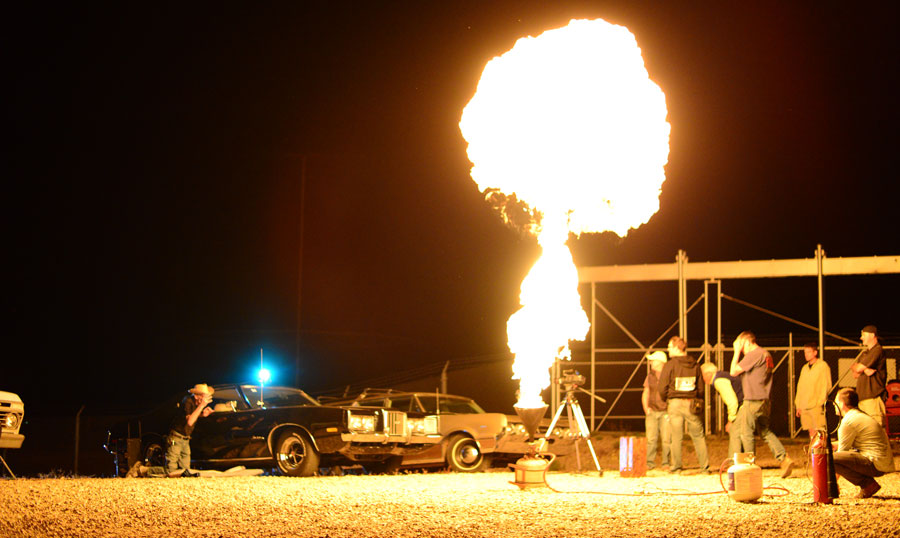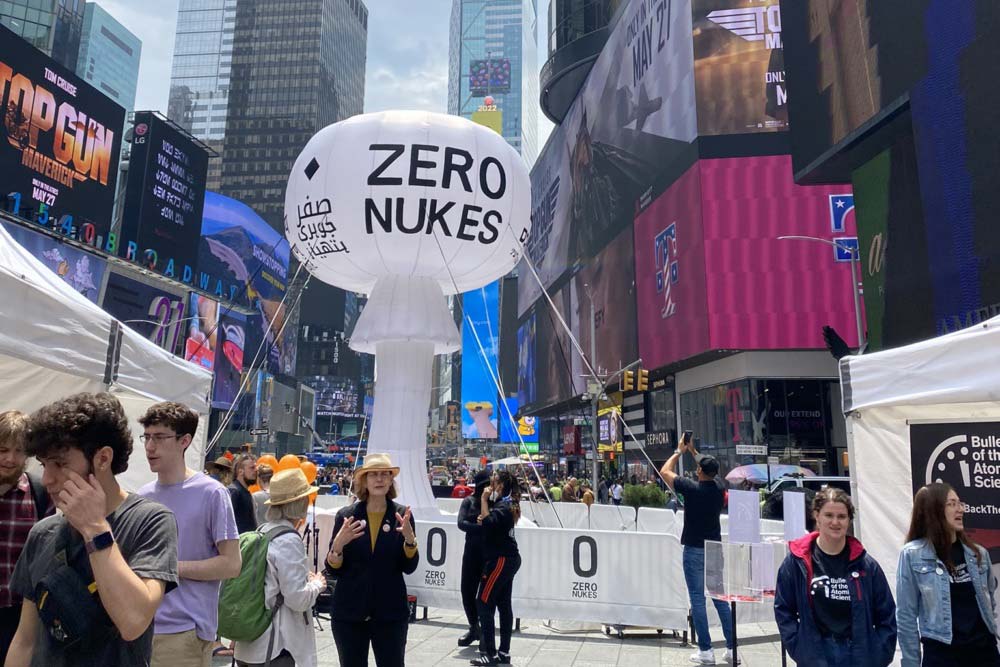From art installations to virtual reality experiences, activists find new ways to expand and connect audiences to the growing concern of nuclear weapons.
Communicating the growing risk of nuclear weapons has been a complicated endeavor for decades. The current era of constant messaging and misinformation has made it even more difficult.
Since 2013, one strategy MacArthur has developed as part of its nuclear grantmaking is to support new, creative voices to cut through the noise and reach more people to deliver messages about nuclear concerns.
From art installations to virtual reality experiences, activists are redefining how to connect audiences with today’s nuclear challenges.
Mexican artist Pedro Reyes’ 30-foot-tall inflatable mushroom cloud sculpture—designed to call attention to the need for disarmament—is an example.
So is an animated film from Bombshelltoe, a creative arts organization focused on nuclear risk. The project explores the enduring homesickness felt by the people of the Marshall Islands decades after being displaced for U.S. nuclear testing.
“These grants were specifically designed to further open the field to new voices,” said Emma Belcher, former director of MacArthur’s Nuclear Challenges program and current president of Ploughshares Fund. “We wanted to be able to attract and support people with different backgrounds and perspectives to really challenge the status quo thinking and include those who had been excluded.”
As the environment around nuclear challenges has changed, particularly in the last decade, MacArthur has re-evaluated how best to draw attention to the threat. Foundation leaders believed that adding creative voices would lead to more productive discussions and debates on ways to create sustainable policy decisions with better long-term impact.
To promote innovation, MacArthur and its partners created N Square in 2014, an organization with the specific mission of encouraging creative ways to think about nuclear threats.
N Square has worked to unpack nuclear threats and discern how they are created through various interactions. The organization looks at connections between belief systems, ways of communicating, political interplay, technology advancements, and more.
It also has sought to start new conversations with new players, creating communities and cross-organization relationships that can help shake up the dialogue.
Art with Social Impact
The result has been innovative work in unusual environments, such as coursework at the Rhode Island School of Design (RISD) that integrates industrial design and nuclear security.
The courses emerged from N Square’s initial public outreach, said Tom Weis, an associate professor at RISD. He first considered integrating nuclear safety issues into his design courses after learning more about N Square’s work in 2015 at a PopTech conference.
Since then, Weis has developed and taught several courses on industrial design, culture, and global security. The courses have led to alums working with Sandia National Laboratories on a project relating to the strategic implications of future nuclear trends and what those could mean for security.
“We started by recognizing that when events happen, they don’t happen in isolation,” Weis said. “Our work focused on questions, such as ‘What does it look like when things collide, and what are the implications of those collisions?’”
Students were able to explore some of the same themes and activities that were designed for leadership at Sandia National Laboratories. They also had the opportunity to share their ideas and explorations with analysts from the labs.
Other research at RISD has focused on the relationship between cultural messaging and nuclear weapons. That work has included media projects in music production, games, and even popular food. The projects have encouraged a new generation of designers to think much more broadly about integrating social issues—including nuclear risk—into their work.
“They are incredibly interested in finding ways to apply the things they value and believe in into their design work,” Weis said. “So many students want to have a social impact and make a difference.”
Virtual Atomic Detonation
Imaginative storytelling has been another tool for increasing awareness of nuclear risks. The 2016 documentary, “Command and Control,” tells the story of a deadly 1980 accident related to the U.S. military’s storage of nuclear missiles.

As part of making the documentary “Command and Control,” a film crew recreated explosions that erupted during a deadly accident in 1980, stemming from the storage of nuclear missiles in Arkansas.
The film humanizes the people who make decisions that could impact millions and illuminates limitations on safeguards in place to ensure the decisions are sound.
“What was amazing to me is that these things were manned by these young kids with very little preparation,” said Robert Kenner, who directed the film based on Eric Schlosser’s 2013 book of the same name, “and how a simple, everyday accident could put half the country at risk of annihilation.”
Other creators use the possibilities of emerging technologies to engage new audiences.
A virtual reality experience, “On the Morning You Wake (To the End of the World),” recreates a false alarm incident in 2018 and gives viewers a sensory experience of living through an atomic detonation.
The virtual reality platform made it possible for a mix of voices, music, and visuals to tell the story without having to resort to mushroom cloud sensationalism, said Alex Glaser, co-creator of the project.
“The key for us was the realization that writing academic papers or op-eds is just not going to reach a broad and younger audience,” said Glaser, who also co-directs Princeton University’s Program on Science and Global Security.
The trailer for “On the Morning You Wake (To the End of the World)” offers a glimpse of the immersive experience about nuclear threat.
Opportunity for Outsized Impact
The emergence of new voices underscores how the creative approach to nuclear nonproliferation has shaken up the field.
Laicie Heeley, founding CEO at nonprofit Inkstick Media, also hosts “Things That Go Boom,” a podcast that makes nuclear-themed topics relatable to younger audiences. Inkstick Media, which describes itself as being “tired of jargony acronyms and contrived technicalities,” works to bring non-traditional voices to topics such as nuclear risk.
Belcher is encouraged by the grantees’ work. “This is what we hoped would happen: the introduction of a new infusion of fresh thinking and creative ideas in the nuclear field.”
Since 2015, MacArthur has provided more than $6.5 million in support to a number of organizations, including N Square, Inkstick Media and Rhode Island School of Design, working in creative arts and journalism to address nuclear threats.




